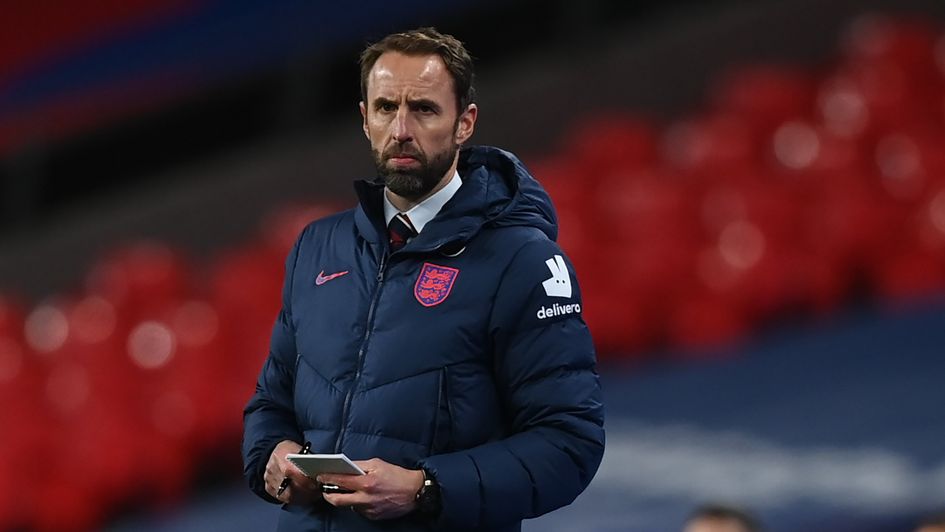England may be the spiritual home of 4-4-2 but Gareth Southgate spent the 2018 World Cup as one of the few managers to prefer a three-man defence.
He played in both formations for his country. The build-up to his second major tournament as a manager has revolved around a decision between them.
The statistical evidence suggests the choice should be simple. Since the last World Cup, England have played nine games with a back three, winning four, drawing two and losing three. Their tally of 14 goals is just 1.55 per game, the eight conceded amounting to 0.88.
With four at the back – and the ability to field both an attack-minded midfielder and a front three – their record is dramatically better: 16 victories out of 20 (an 80 percent win rate instead of 44), just two defeats (losing 10 percent, not 33) and a glut of goals. England have 66 goals, 3.3 per game, at the right end while conceding 13, 0.65 per match, at the wrong one.
Euro 2020 qualifying feels distant but England, with 37 goals in eight games, ranked second only to Belgium, who played two matches more, in the scoring charts.
In international football, where the standard of opponents can vary dramatically, the numbers can camouflage the context. England’s defeats playing 3-5-2 or 3-4-3 came to Belgium, Denmark and Spain, all currently in the top 10 of the world rankings, one after a first-half red card. Their losses with only two central defenders were to Holland (currently 16th) and the Czech Republic (40th). England may be likelier to thrash the lesser lights with fewer centre-backs but they could also be at a greater risk of losing to them.
The impression was that Southgate’s 2020 reversion to a back three came because he felt his side had scorers but needed to reduce games to fewer chances. Belgium and Denmark registered three and four shots on target respectively in beating England; Holland had 13, albeit in 120 minutes, and the Czech Republic eight against Southgate’s back four.
But the lack of chances can be the case at both ends of the pitch. England were not prolific with a back three in the 2018 World Cup; three of Harry Kane’s six goals were penalties, two more came indirectly from corners and the other was a Ruben Loftus-Cheek's shot deflected in off his heel.
As the three goals Harry Maguire and John Stones scored came from set-pieces, that only leaves two open-play goals, one each for Jesse Lingard and Dele Alli.
Kane won the Golden Boot in the World Cup and was the 12-goal top scorer in Euro 2020 qualifying, but there was a marked difference; nine were non-penalty goals. Sterling, who did not score in the World Cup, got eight.
He had six assists to Kane’s five. Ross Barkley has faded from contention, but his four goals showed what the most progressive of the three midfielders – probably Mason Mount, who has four goals in his last 11 internationals – can offer.
Southgate’s relatively young squad have a common denominator: apart from Kane, none of the forwards or midfielders have scored in a major tournament. Sterling has played 12 games and Marcus Rashford eight, but the rest are untried.
Given the competition for places between Sterling, Rashford, Phil Foden and Jadon Sancho, the numbers show the wealth of options at Southgate’s disposal. Between them they have 73 goals for clubs and country this season (Rashford 22, Foden 18, Sancho 17, Sterling 16) and 54 assists (Sancho 19, Rashford 13, Foden 13, Sterling nine).
Sterling’s goal tally has gone down this season but his xG is the highest, showing his ability to get into dangerous positions.
Rashford is the most shot-happy, averaging 2.2 per game, with 1.09 on target. Sancho supplies the most key passes per match, at 1.71. Sterling, perhaps surprisingly, is the most accurate passer, at 87 percent.
Foden provides the most crosses, but Sancho, who is only narrowly behind, has the best cross completion rate, at 25 percent. Phil Foden loses the fewest balls but Sancho recovers the most, suggesting he is the best at pressing. Sancho also dribbles the most per match, though Rashford has made more in total.
The fifth, and different, alternative is Jack Grealish, who averages fewer goals and shots, but ranks alongside Sancho for dribbles and top of the quintet for key passes per match. Given his background as more of a midfielder, it is perhaps unsurprising he is second only to Sancho for average passes per game.
Southgate’s standout results playing 4-3-3 came with a front trio of Sterling, Kane and Rashford, who started in the 2018 wins over Spain and Croatia. They began together again in the 4-0 and 6-0 wins against Bulgaria. But each of those games came before Foden and Grealish’s England debuts and they have added to the options.
The sense is that England have greater strength in depth in attack than the middle of defence and only two defeats since the 2018 World Cup have come when Stones and Maguire have both started: against Spain in 2018 in a trio with Joe Gomez and versus Holland in the 2019 Nations League. Subsequent losses have come with at least one of Michael Keane, Eric Dier, Conor Coady and Tyrone Mings starting.
England’s fortunes can depend on the shape, but the presence of the premier defenders plays a part too.
